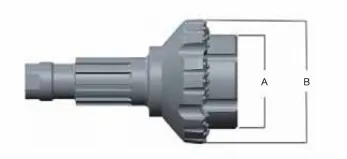- Afrikaans
- Albanian
- Amharic
- Arabic
- Armenian
- Azerbaijani
- Basque
- Bengali
- China
- China (Taiwan)
- Czech
- Danish
- Dutch
- English
- French
- German
- Greek
- Gujarati
- Haitian Creole
- hausa
- Miao
- Hungarian
- igbo
- Indonesian
- Italian
- Japanese
- Javanese
- Rwandese
- Korean
- Kyrgyz
- Lao
- Lithuanian
- Luxembourgish
- Macedonian
- Malgashi
- Malay
- Mongolian
- Myanmar
- Nepali
- Norwegian
- Persian
- Polish
- Portuguese
- Punjabi
- Russian
- Spanish
- Swahili
- Swedish
- Telugu
- Vietnamese
Dec . 03, 2024 16:58 Back to list
down the hole drilling rig
Understanding Down the Hole Drilling Rigs An Essential Tool in Modern Mining and Construction
Down the hole (DTH) drilling rigs are specialized drilling equipment used mainly in mining, quarrying, and construction industries. They play a crucial role in the drilling process, enabling the creation of deep, precise boreholes for various applications. With their ability to perform efficiently in challenging geological conditions, DTH rigs have become indispensable tools in the extraction of resources and in the setup of infrastructure.
What is Down the Hole Drilling?
DTH drilling refers to a method where the drilling bit is located at the end of a drill string, below the surface of the ground. This technique is distinguished by the use of high-performance percussion hammers, which are positioned on the drill bit. DTH drilling involves the use of compressed air to deliver rapid impacts, breaking rock into smaller fragments. This method is particularly effective in hard rock formations, making it a preferred choice for mining operations and various drilling applications.
Advantages of DTH Drilling Rigs
1. Depth and Efficiency One of the most significant advantages of DTH rigs is their ability to drill to greater depths compared to conventional rotary drilling methods. They are capable of drilling depths exceeding 100 meters with great precision, which is essential in mining operations for reaching ore deposits.
2. Versatility DTH rigs can be utilized in various applications beyond mining, such as construction, water well drilling, and geotechnical investigations. Their adaptability to different drilling sizes and configurations makes them useful across multiple industries.
down the hole drilling rig

3. Reduced Costs Although the initial investment for DTH rigs can be high, their efficiency and speed in drilling operations can lead to significant cost savings in the long term. The ability to drill faster and more accurately reduces overall project time and labor costs.
4. Minimal Vibration and Noise Unlike traditional drilling methods that may cause significant surface vibration and noise, DTH drilling produces cleaner operations. This characteristic is crucial in urban areas and sensitive environments, leading to fewer disturbances.
5. Improved Penetration Rates DTH rigs deliver higher penetration rates, allowing projects to progress more quickly. The utilization of air-powered hammers means fewer interruptions compared to other drilling techniques, which rely on continual drilling fluid supply.
Key Components of DTH Drilling Rigs
A DTH rig comprises several critical components that work together to ensure efficient drilling operations - Percussion Hammer This device is responsible for striking the drill bit, providing the necessary force to fracture rock. - Drill Bit The drill bit is specifically designed to handle various rock types. It is typically made from durable materials like tungsten carbide. - Compressor A high-capacity air compressor supplies the necessary airflow to operate the percussion hammer and clear debris from the borehole. - Drill Rods These are the connecting links between the surface rig and the drill bit, allowing for the transmission of energy and air.
Conclusion
Down the hole drilling rigs are a revolutionary advancement in the drilling industry, providing enhanced efficiency, depth, and versatility. As industries continue to evolve and demand more efficient resource extraction methods, DTH rigs will likely play an increasingly prominent role in meeting these needs. By understanding the benefits and components of DTH rigs, companies can make informed decisions that enhance their operational capabilities and overall productivity. The future of drilling lies in these innovative technologies, paving the way for sustainable and efficient practices in mining and construction.
-
Low-Cost Borehole Drilling Machine for Small-Scale Projects
NewsJul.11,2025
-
Carbide Bullet Teeth for Abrasive Formations: Powering Industrial Drilling Efficiency
NewsJul.11,2025
-
Advantages of Down-the-Hole Drill Bits in Geothermal Projects
NewsJul.11,2025
-
Hole Hammer Use in Water Well Drilling
NewsJul.11,2025
-
Benefits of a Mobile Diesel Compressor in Construction
NewsJul.11,2025
-
Benefits of Diesel Portable Screw Air Compressors
NewsJul.11,2025

















